Overview: Our 5th tour exploring Finland was dated a pair of weeks earlier than previous issues. The average temperature was low during the whole trip, and the early dates marked the tour, improving our chances for Grouses and Owls, but also making not possible to connect with some species including Terek’s Sandpiper, Common Rosefinch and Greenish Warbler. However, the early date provided us with better chances for both Steller’s & King Eiders and some interesting migratory species (Marsh Sandpiper, Greater White-fronted Goose, Purple Sandpiper), while the cold ambient was excellent to spot Grouses in the taiga forest. The number of Owls was extremelly high, especially aorund Oulu. Here, we counted a minimum of 20 Short-eared Owls in a single day!
All images in this trip report by tour leader Carles Oliver
- Dates: 19th to 28th May, 2022
- Number of participants: 8 +1 tour leader
- Species along the tour: 171
Day 1. After meeting in Helsinki Airport, the whole group of participants landed in Oulu in the afternoon. The beggining of the tour was delayed as we had to wait for our bus to come, but even from the airport terminal we already had a good sensation about the trip since one of the very first birds to appear was Short-eared Owl flying above the parking of the airport. Other birds noted while waiting included the first of many Yellowhammers and Tree Pipits.
Once in our accommodation we had an early dinner, and after dinner we enjoyed some pre dawn birding in a localy location nearby. There we enjoyed the first displaying Ruffs along with several Wood Sandpipers and Common Snipes. A Greater Bittern was booming in the distance, and Reed Buntings were singing all around. This location, a lovely bay with an extensive bog plain around produced also 6 White-tailed Eagles, Marsh Harriers, Dunlins, 2 Greenshanks, Whooper Swans and hunting Short-eared Owls. Small flocks of Common Cranes were feeding in the fields nearby, the song of Pied Flycatchers emerged from the woodlands close to the sunset, and a male Whinchat joined them for a little while. In our way back to the accommodation European Starlings and Rook were both noted.


Day 2. A very early start to explore some typical places for some of the wonderful Owls living around Oulu. It was a really cold morning, with temperatures far below the average, arriving to -4ºC! Not far from our accommodation we had the first surprises of the day, as we had several Black Grouses displaying along the lane, some of them in the open fields, others flying away as our van recheaded them. We crossed several good spots a low speed, and we were granted we our firsts Western Capercaillies of the tour, including a wonderful male that showed out for us in the top of a pine.
Soon after we arrived to the first key place, where a Northern Hawk Owl had been hunting the last days. We didn’t have to wait long before the Northern Hawk Owl showed out of the forest, landing in the wires and allowing excellent views. The bird spent some time hunting around and we could all enjoy views of the bird hovering and diving on the grass in search of prey.



During the morning we counted 20+ Short-eared Owls, that seemed to be everywhere! We always thought that we would be granted with a close view soon or later, but that never happened this time…
A second stop in the morning produced another wonderful moment of our group. A Great Grey Owl was seen standing up in a meadow by the our road, so we had a stop and enjoyed wonderful views on the bird moving in the field and even catching a prey before vanishing into the woods. Even if the stop was short, we again had 2 Short-eared Owls moving in the fields around!
We kept moving into the woodlands, with more Black Grouses here and there and eventually some Eurasian Woodcocks flying around until arriving to one of the several territories of Eurasian Pygmy Owls around Oulu. Coal Tit and Mistle Thrush were added to our list but a nice (pressumed) male stole the show when decided to stop really close to us in a dead branch. For 5 minutes, we all enjoyed great views on this tiny Owlet, and when decided to leave the spot, the Owl was still sitting on his branch, enjoying the very early morning ambient in the forest.
It was already mid morning, so we had a break to enjoy some coffee before going on with some more birding. Lesser Whitethroats were singing around, and the first of many Eurasian Bullfinches and Common Crossbills of the trip were also seen. But the best surprise of the stop was to enjoy more than decent views on a Black Woodpecker that was feeding around the area!

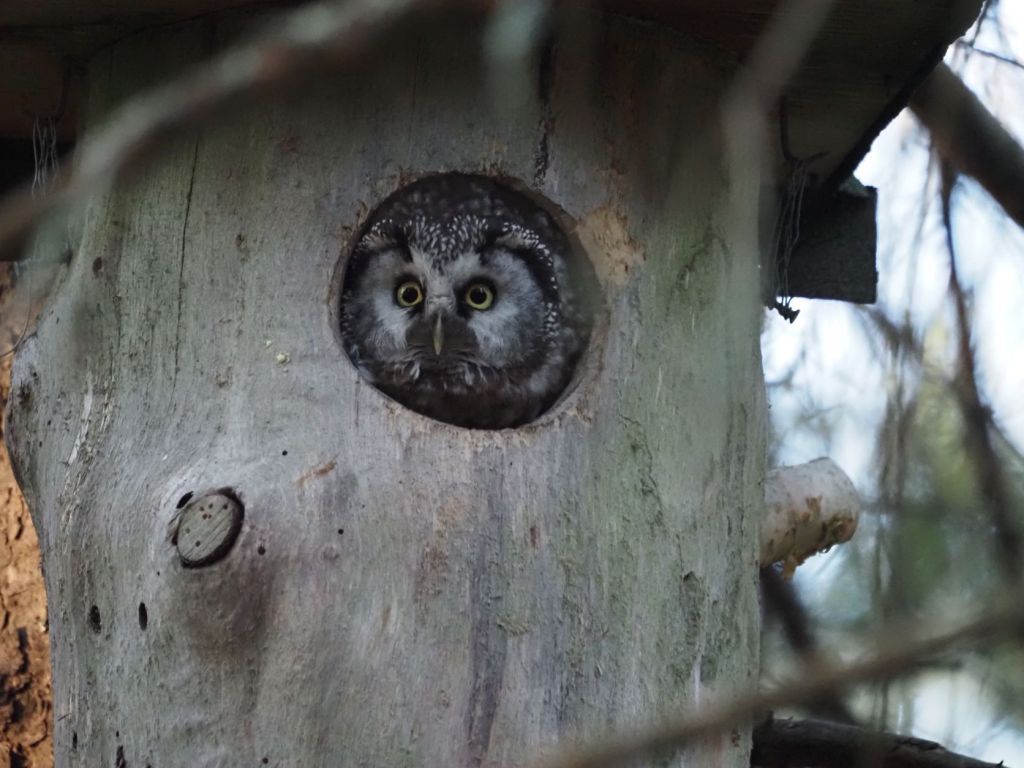
Back into the boreal forest, we visited a nest box for Tengmalm’s Owl, and we also enjoyed good views on the bird taking out the head from its whole and watching us. From here, a short drive was mandatory to explore one of the typical corners for Ural Owl, and we were again granted with excellent views on a adult of this magnificient Owl! It was one of the tour participants who found the massive Owl roosting in a pine, and we had 15 minutes to admire and take some shots on the bird. Always respecting the distance so the bird was not disturbed.
After such a wonderful morning we drove back to our accommodation to have some rest. After lunch and rest, we visited a pair of places in the afternoon. Before dinner, we visited a corner near Oulu in the search of Terek’s Sandpiper. There, we enjoyed Common Ringed and Little Ringed Plovers, Common Sandpipers, Arctic Terns, Whinchats and singing Skylarks, but no sign of the Terek’s Sandpipers.
The last stop in the afternoon was to explore the large belt of marshes South of Oulu. Here we had a good list of waders, but also enjoyed good views on 1 Marsh Sandpiper along with several Wood Sandpipers and some Common Greenshanks. We had good scope views on the Marsh Sandpiper but not long because it was all the time getting inside the many ditches around.


After this 2nd stop we drove back the small distance to our accommodation to get an early dinner. After dinner, everybody with still some energy went for a walk inmediatly around our accommodation. A new booming Greater Bittern was listened around as well as a good variety a good selection of waders that included two Spotted Redshanks, Eurasian Oystercatchers and Common Ringed Plovers to name a few. In the distance, we also had a small flock of Barnacle Geese (now nesting in different places along the Baltic See), Great Crested Grebes (the only ones along the trip) and 2+ Great Northern Divers feeding in the bay.
Day 3. Early morning start to explore a pair of spots before our midday transfer to Kuusamo. The first spot was to check a nesting place of Great Grey Owl around Oulu. After some searching in the place, we enjoyed wonderful views not only of the female in the nest but also on the perfectly camouflaged male nearby!

A second stop was to done North of Oulu, and even before arriving to the location we had excellent views on a pair of Hazel Grouses feeding on the ground, very vocal and moving in the woodlands. Very happy after such a great success, we still scanned around the area looking for other goodies, but Eurasian Robin and Reed Buntings was everything that we could see. After this scanning we went to search for some of the Pallid Harriers nesting around. The different stops along the morning produced Short-eared Owls, White-tailed Eagles, Rough-legged Buzzards, 3 Hen Harriers, several Marsh Harriers and even a Black Kite and 1 Eurasian Hobby (both species pretty scarce in the area), but unfortunately we couldn’t contact with any Pallid Harriers. Special mention required for a lovely pair of Garganeys that were spotted in our final stop that morning.


After lunch we drove to Kuusamo, where we did arrive in the late afternoon. En route, a stop was mandatory to enjoy the first of many females Western Capercaillies along the trip. All the clients enjoyed great views on this gorgeous female! Once in our accommodation, our guests enjoyed some free birding in the lake and forest around the hotel, enjoying good views on the nesting Goldeneyes, Black-throated Divers and Whooper Swans before dinner.
Day 4. Very early start that morning to explore the gorgeous boreal forests around Kuusamo. Before doing some walk in selected areas we had some “game drive” in some areas which are normally great for grouses. In about 30 minutes of drive we got 10+ Capercaillies and 2 Willow Grouses! We changed the area, and in a different lane we still got more Capercaillies (it looked like being everywhere) and 15+ Black Grouses, some of them lekking directly in the tarmac!

After such a great start, we went to explore one of the most famous corners in the Kuusamo. This hill, with a good spruce forest in the top, is hosting some of the most wanted birds in the region. Unfortunately the rain was going to join us during the rest of the morning, but still we got 2 Bohemian Waxwings moving around and good views on 1 Red-flanked Bluetail while singing. The variety of birds was low, anyway. A further walk under the rain only produced Song Thrush and flocks of Crossbills passing away.
We had to wait until the stopped at mid-morning. Then we tried again the same spot, having good but good views on Parrot Crossbills and amazing views on 2 Siberian Jays that delighted the photographers in the group.
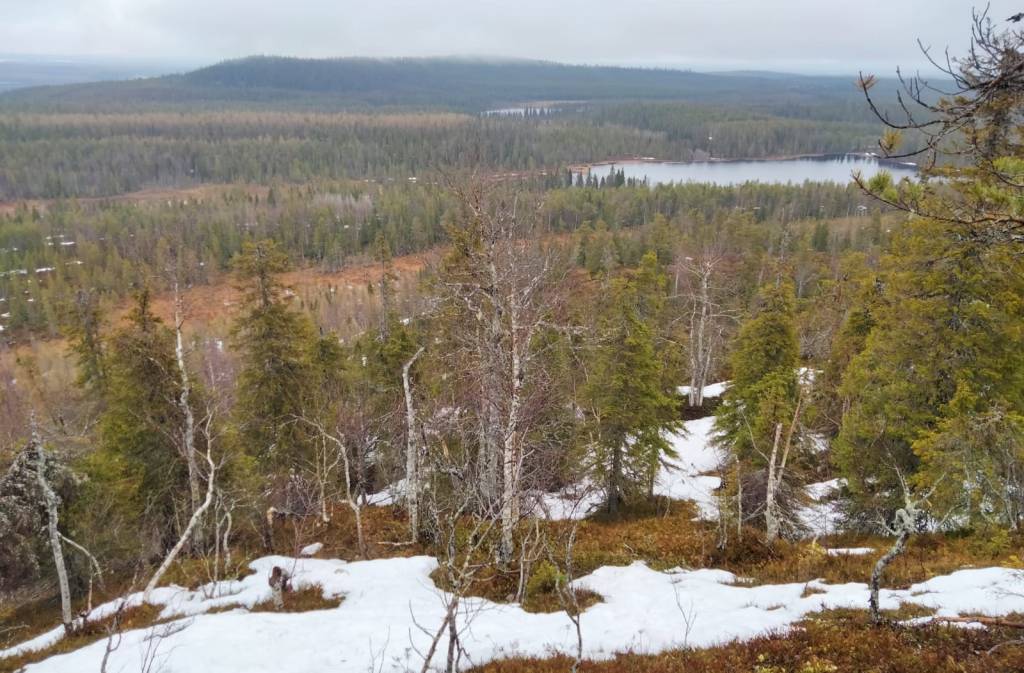

After our early lunch and a good nap, we went out to check out a pair of locations around Kuusamo. Our first stop produced excellent views on Mountain Hares, but also Eurasian Wigeon, Pied Flycatcher and Eurasian Woodcock singing around. But the best birds on this small grassland were a superb pair of Rustic Buntings that came to us, allowing excellent views by everyone in the group! After this stop we went to enjoy a colony of Little Gulls in the area, and we found more birds than ever before, allowing really close views on some pass by birds. Along with them, 4 Red-necked Grebes in full summer plomage were a wonderful way to end our afternoon.

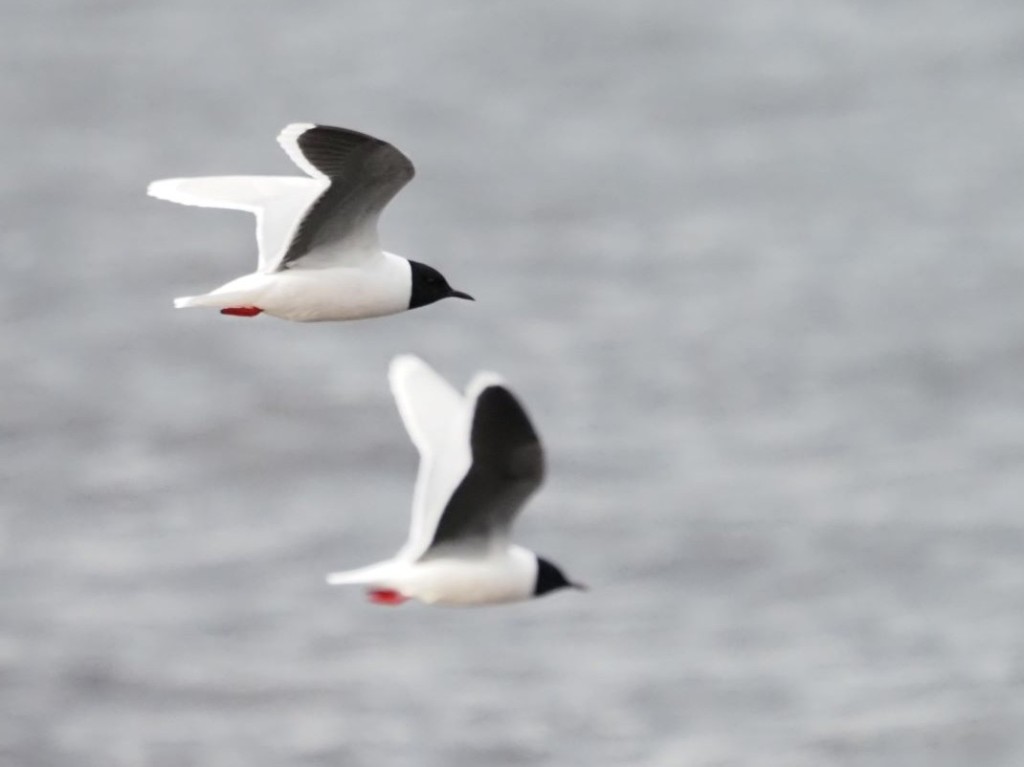

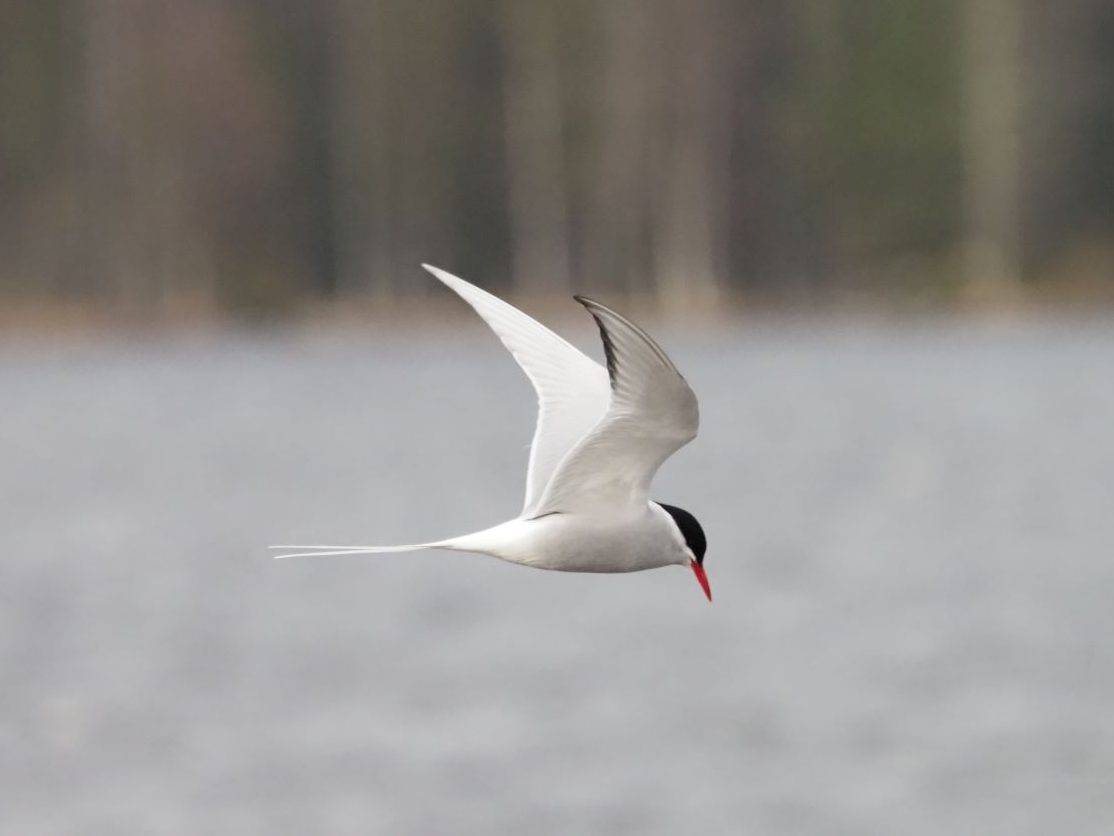
Day 5. Another really early start. After a wonderful breakfast, our first stop was to explore one of the best corners to enjoy Willow Grouse, and even before getting out of the van we were listening a bird singing around. After a short strall we got excellent views on a male singing from the top of a birch tree. 2 Rustic Buntings were also seen around, and the stop produced also a flock of migratoy Yellow Wagtails, and a male Eurasian (Northern) Bullfinch.






The second stop of the morning was devoted to have better views on Red-flanked Bluetail, and after some walk, we had wonderful views on a lovely male, but also Common Redstart, another male Rustic Bunting, Northern Goshawk and extremely confiding Siberian Jays!
From here we still visited another area of boreal forest, still searching for Tree-toed Woodpecker. Unfortunately we had no luck with this specialty but we got our first drake Smew, but also Scandinavian Willow Tits. In our way back, another stop was mandatory as we spotted a pair of Hazel Grouses. After some waiting, we all enjoyed amazing views on the male while singing and performing for us at close range!
After a stop and a coffee it was time to go North. From Kuusamo we drove North, getting inside the Northern Circle Pole. After an en route lunch, our last stop of the day was to explore a gorgeous patch of spruce forest really close to Ivalo. In here, one of my favourite spots in Finland, we had a pair of stops but it didn’t take long before we had our first Siberian Tit appearing and showing in front of us! A second stop produced another pair, and along the we had 3 Capercaillies and really close views on Black Grouses (both males and females).
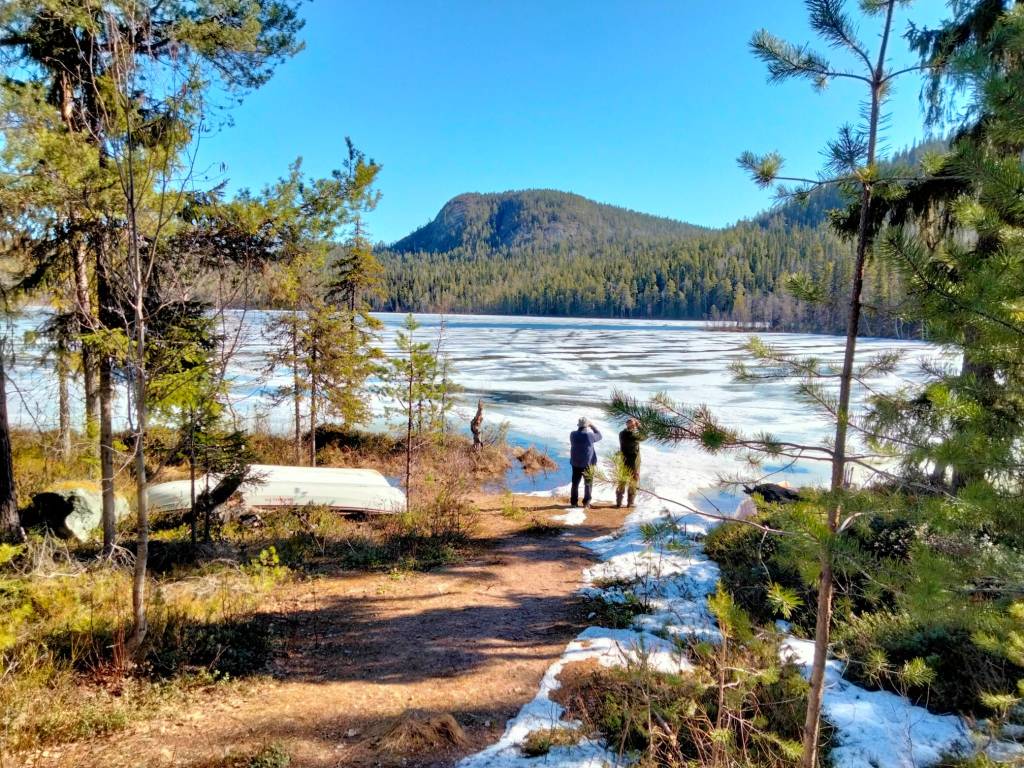





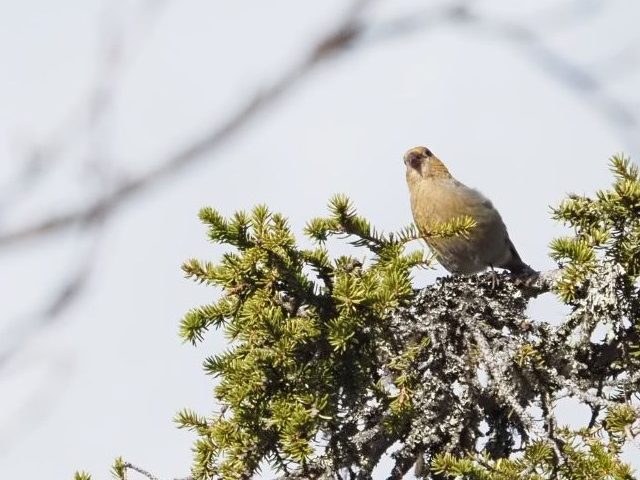



A short walk around, even if it was at mid-afternoon, produced Siberian Jay, Bohemian Waxwing, Siberian Tit and Mealy Redpolls. But the very best birds of the afternoon were a pair of Pine Grosbeaks feeding, and the male even singing extremely close from the path. Our group enjoyed a 20 minutes long view in this amazing, and often extremely hard to find bird! In our way out of the area, we still had to stop again as 2 Willow Grouses were lekking in the dart road, and provided us, again, with unforgettable views!
Day 6. After the previous successful days, we decided to have a slightly later start today. After breakfast, we kept moving North towards to Norwegian border. In our way, we had a pair of stops to enjoy Rough-legged Buzzard and a pair of nesting Peregrine Falcons. Siberian Tit and Great Grey Shrike were other “en route” birds.

Once in Norway, we enjoyed excellent views on Rough-legged Buzzards and we had a mandatory stop in the road to enjoy some really close Moose. Keeping our way North, we had a stop in an estuary to look for migratory waders and geese. Here we had the only 2 Greater White-fronted Geese of the trip, and also 2 Tundra Bean Geese. The area was hosting some waders such as Eurasian Whimbrel, Sanderling, Ruddy Turstone, Dunlin in lovely full nesting plomage, Little Stints and the first Temminck’s Stint of the trip: a calling bird that was flying around the hide.
Getting inside Varanger is always a great experience, and soon we were enjoying great views on a number of White-tailed Eagles and Rough-legged Buzzards. A pair of Short-eared Owls were also noted, as well as the first of many Arctic Skuas. Before arriving to our accommodation we had some scanning in the bay around, and we were lucky enough to find 6+ Steller’s Eiders roosting along with Common Eiders, and including 3 drakes! While enjoying the birds, a close Temminck’s Stint feeding along Dunlins was also a nice adding! Happy with the scope views, we had a break and some members of the group decided to try closer views on the birds while exploring the meadows and coastline around our hotel.



In the afternoon, the Steller’s Eiders were moved to the other side of the bay, so we drove and enjoyed excellent views on the birds while swimming and feeding, sometimes getting at close range of our group! Everybody was delighted with these magnificient birds as it was one of the main targets for most of our clients. Along with these beauties, the area produced the first of many Kittiwakes of the tour along with several Dunlins, Ruffs and some drake Bar-tailed Godwits.
Before dinner, we still had time to explore a first patch of tundra. Unfortunately it was windy so the number of birds was low. Still, we had good views on Meadow Pipits and European Golden Plovers but the best bird of the stop was a stunning Bluethroat singing his heart out!

Day 7. Again a windy day in Varanger. The pre-dawn strall didn’t produce much because of the wind. After breakfast we went North to Vardo, where a small boat brought us to the bird colony in Hornoya. It is quite difficult to put down in words how an experience such as visiting Hornoya is. Tens of thousands of birds nesting, calling, yelling in cliffs. Waves of birds taking off from the roks to the sea: Guillemots (about 20% being “bridled”), Razorbills, Kittiwakes and wonderful Puffins nesting around! Atlanlic Shags a few inches away from you, nesting under rocks on the ground. Broken eggs of Auks on the ground, and the intense smell all around!
But Hornoya is also home for one of the easiest accessible colonies of Brünnich’s Guillemot, and once we were in the island, our first target was to find some of them. Even if not specially common, it didn’t take long before we had some of them nesting in the cliffs. Once located, we had some time enjoying the very close views on the Auks. We also had a confiding flock of Purple Sandpipers that catched our attention while a pair of Razorbills were mating only inches away from us! Rock Pipits were also seen around, catching insects but also exploring broken eggs while Great Black-backed & Herring Gulls were patrolling the area. Black Guillemots were scarce in the island this year, but we still got to see some around.


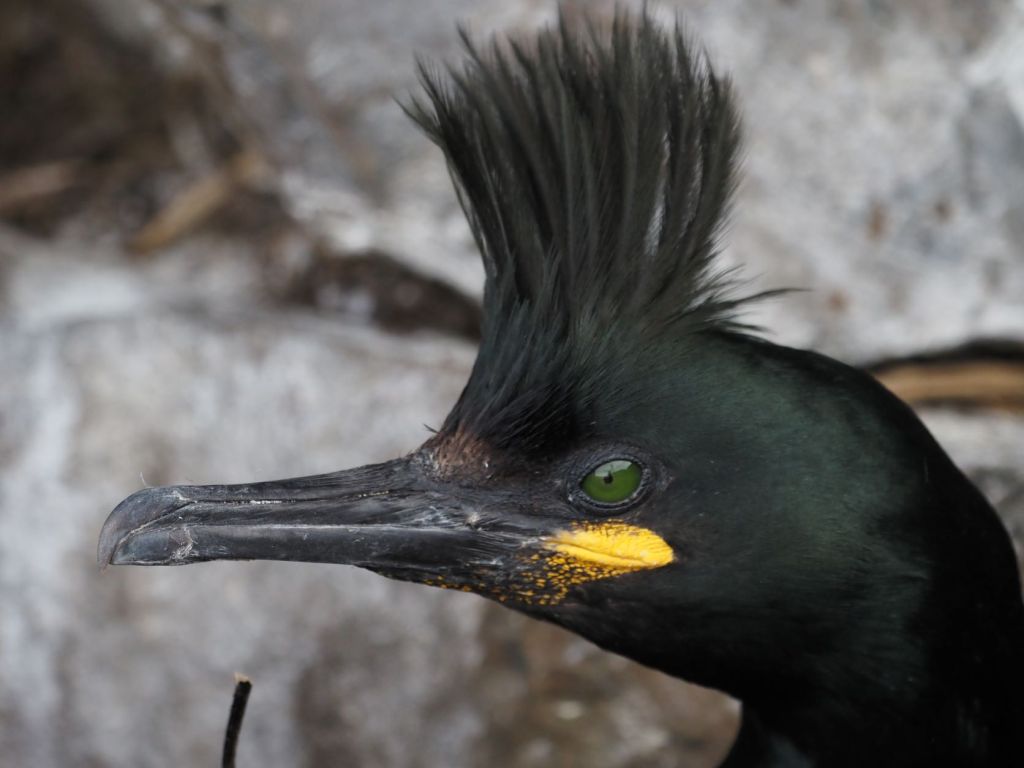
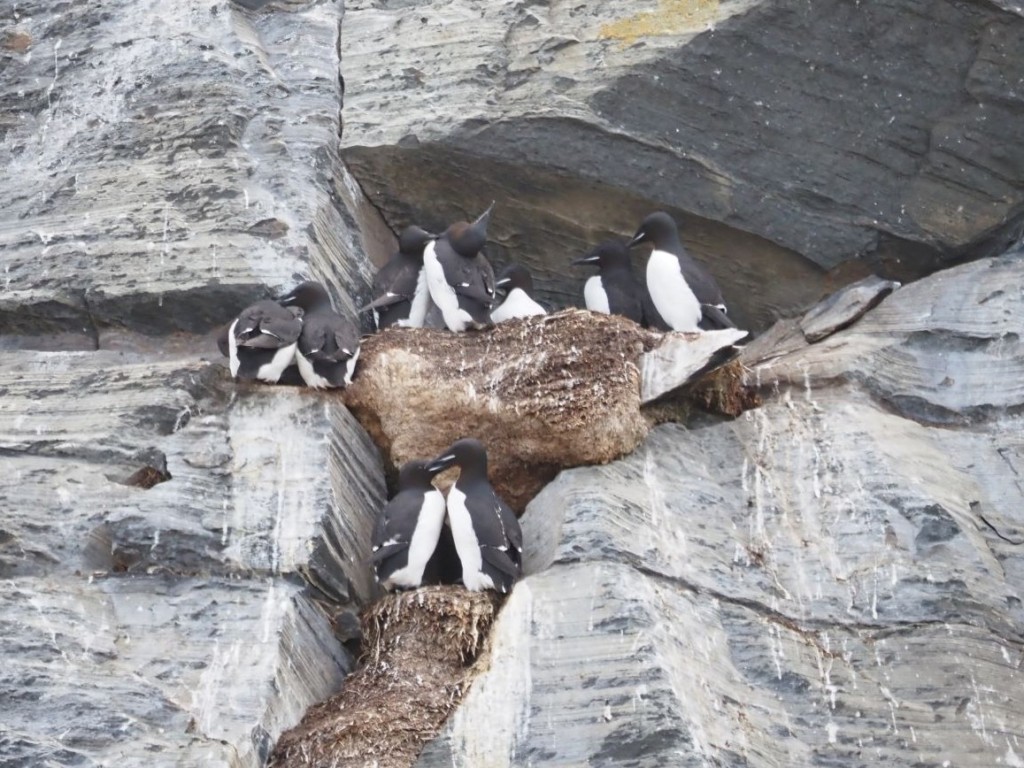






In the distance we could the Greylag Geese nesting a close island, but our eye was permanently in the sky, looking for anything interesting to appear. 2 White-tailed Eagles were also patrolling the cliffs, and their movements produced waves of Auks leaving the nesting sites in search of shelter down in the ocean. We never saw any of the eagles catching an Auk, but they didn’t look in a hurry… Even if our main target in the sky never appeared (too early in the season?), we were granted with a pastby Glaucous Gull.
Back in the continent, we spend the afternoon exploring the tundra and the many bays between Hornoya and Hamminberg. The wind was still blowing, but even with it we soon had great views on some males Lapland Buntings. Several Arctic Skuas were also moving in this spot, already chosing the nesting site and being monitored by the White-tailed Eagles around. European Golden Plovers, Rough-legged Buzzard, Red-throated Pipits, Ruffs, Common Snipes, Wood Sandpipers and Common Ringed Plovers were also noted around. Along the bays we had several Long-tailed Ducks, but also Common Eiders, Tundra Bean Goose and large feeding flocks of Goosanders. Black-throated & Red-throated Divers were also seen in different locations.



But the best sighting on our way North were 2 impressive Humpback Whales really close to the coast. One of them was splashing its large pectoral fin in the water, and at times we saw both the pectoral and the tail fins out of the water! It looks like this behaviour is not uncommon during the mating season, when females can do it for quite long to keep the attention of the males!
Once arrived to Hamminberg, we enjoyed good views on Atlantic Gannets fishing close to the coast. Large flocks of Goosanders were in the move to the East while both Long-tailed Ducks and Black Guillemots were all around. Still, the strong wind made the sea watching quite unpleasant. In our way back, a nice Pomarine Skua was also noted and provided us with good views!


Day 8. In the morning we explored a patch of forest were a pair of Northern Hawk Owl was nesting, but unfortunately we couldn’t find it. Still, we got excellent views on Bluethroat while Bohemian Waxwings were moving around. After this stop we moved to center of Varanger, to explore some tundra plateaus. As soon as arrived to the high lands, we had the first Long-tailed Skuas performing for us, chasing each other in long pursuits. They were just arrived, so it means a lot of activity to defend the best corners of the tundra.
A number of stops along the way produced a great list of birds including close ups to Temminck’s Stints, Shore Larks, Lapland Buntings, Bluethroats, Ruffs and 4+ mobile Snow Buntings in shinning summer plomage!

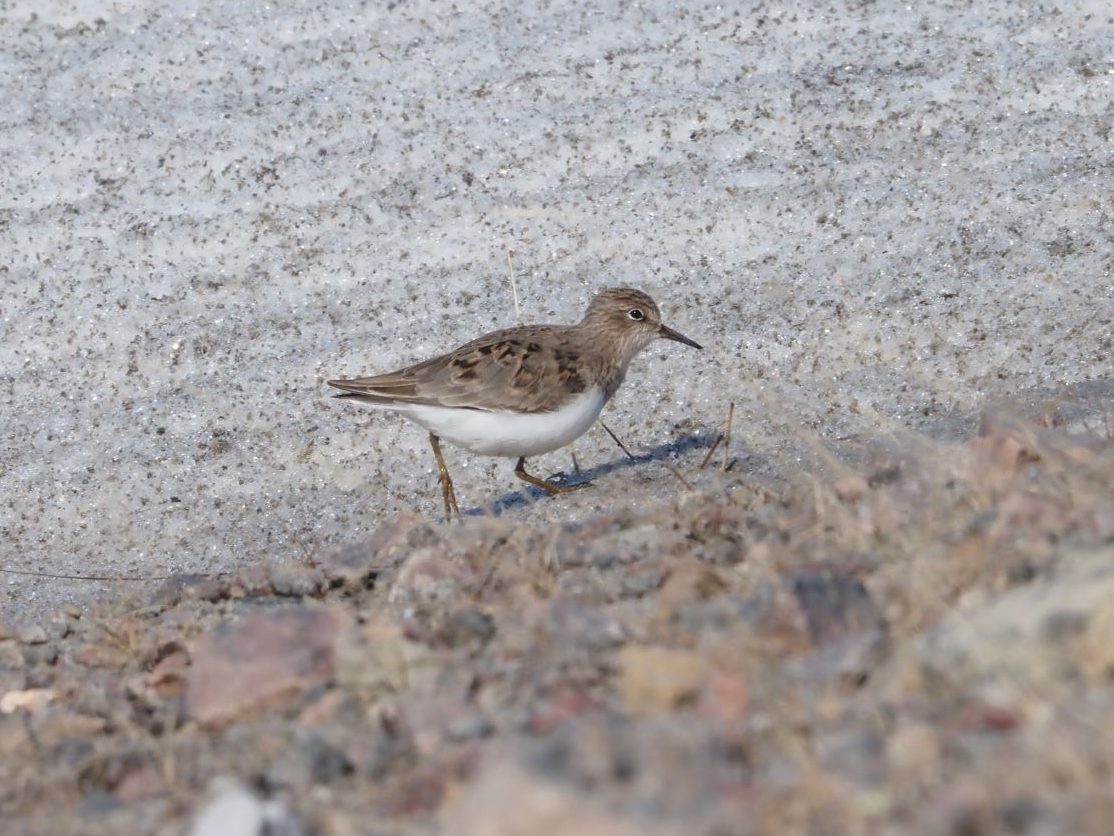
After this successful start in the tundra, we decided to explore the Northern patch of coast of Varanger. There, Atlantic Gannets were fishing all around along with large numbers of Black Guillemots and Long-tailed Ducks. Great Cormorants and Goosanders were migrating East in good numbers and flocks of Purple Sandpipers were noted doing the same. The dramatic landscapes of the area were also the perfect background for small flocks of Twites moving in the grasslands, and a nice pair of King Eiders (female and 2nd year male) that we found inside a flock of 20+ Common Eiders.
Back to the plateau, we had a pair of stops searching for Rock Ptarmigan before we found a wonderful pair of them. Everybody in the group enjoyed wonderful scope views, and some enjoyed a walk in the snow to have closer views and good shots on the Ptarmigans. In our way to our hotel we still had a last stop, since we found an obliging pair of Red-throated Divers feeding really close to our lane.





Day 9. Morning stop in the plateaus in our way South to enjoy more views on Rock Ptarmigans, Snow Buntings and Shore Larks. Unfortunately we were a bit too early for Eurasian Dotterels, but the Long-tailed Skua spectacle was a wonderful reward anyway!
Almost in Finland, we had a last stop in Norwegian territory to scan for Gyrfalcons. Under the intense rain and wind we could only find a pair of Peregrine Falcons while pastby Merlin and Ring Ouzel were noted. Back into Finland, and despite the intense rain, we had a pair of stops in our way to the accommodation to admire close Smews and Bohemian Waxwings were noted again along the road.
During the afternoon, we were hit by the rain and the very strong wind. Still, we decided to explore a pair of corners targeting some specialties that had been scaping to us so far. After some driving, we arrived to one secret pool, were we enjoyed 10 minutes of plain weather, with Bluethroats, Reed Buntings, Yellow Wagtails around and confiding Wood Sandpipers. But the very best were 3 Red-necked Phalaropes landing in the pond quite close and offering some great views even under the incipient rain!
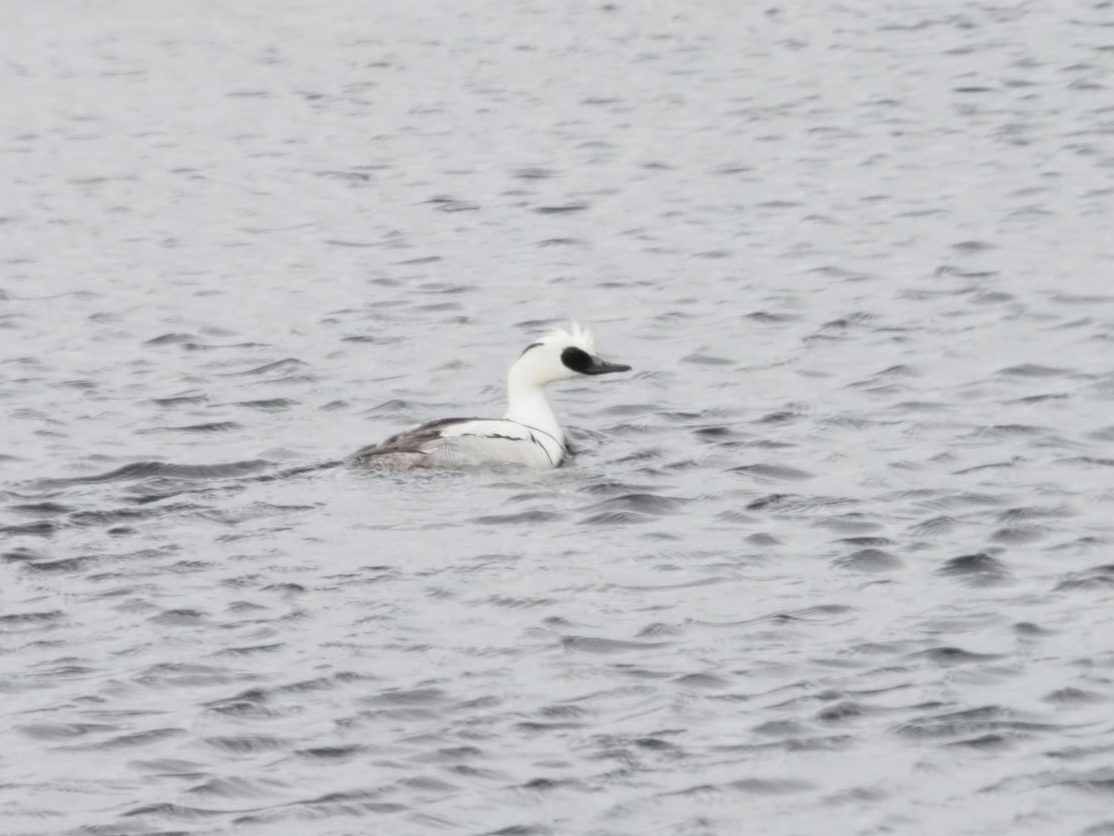

Day 10. Early morning start to enjoy the bird feeders of our accommodation under the rain. Pine Grosbeaks offered great views as so it did the many drake Bramblings and 1 Red Squirrel. In our way to the airport for our morning flight, a very last female Capercaillie showed out as a wonderful way to end our 5th tour exploring Northern Finland and Finnmark!

List of seen bird species during the tour:
- Whooper Swan (Cygnus cygnus)
- Greylag Goose (Anser anser)
- Greater White-fronted Goose (Anser albifrons)
- Tundra Bean Goose (Anser serrirostris)
- Taiga Bean Goose (Anser fabalis)
- Barnacle Goose (Branta leucopsis)
- Common Shelduck (Tadorna tadorna)
- Eurasian Wigeon (Anas penelope)
- Eurasian Teal (Anas crecca)
- Mallard (Anas platyrhynchos)
- Pintail (Anas acuta)
- Gadwall (Mareca strepera)
- Garganey (Spatula querquedula)
- Northern Shoveler (Spatula clypeata)
- Tufted Duck (Aythya fuligula)
- Common Goldeneye (Bucephala clangula)
- Common Eider (Somateria mollissima)
- King Eider (Somateria spectabilis)
- Steller’s Eider (Polysticta stelleri)
- Long-tailed Duck (Clangula hyemalis)
- Common Scoter (Melanitta nigra)
- Smew (Merguellus albellus)
- Goosander (Mergus merganser)
- Red-breasted Merganser (Megur serrator)
- Red-throated Diver (Gavia stellata)
- Black-throated Diver (Gavia arctica)
- Great Northern Diver (Gavia immer)
- Great Crested Grebe (Podiceps cristatus)
- Red-necked Grebe (Podiceps grisegena)
- Greater Bittern (Botaurus stellaris)
- Atlantic Gannet (Morus bassanus)
- Great Cormorant (Phalacrocorax carbo)
- Atlantic Shag (Phalacrocorax aristotelis)
- Black Kite (Milvus migrans)
- Hen Harrier (Circus cyaneus)
- Western Marsh Harrier (Circus aeruginosus)
- Northern Goshawk (Accipiter gentilis)
- Eurasian Sparrowhawk (Accipiter nisus)
- Rough-legged Buzzard (Buteo lagopus)
- Western Osprey (Pandion haliaetos)
- White-tailed Eagle (Haliaeetus albicilla)
- Eurasian Kestrel (Falco tinnunculus)
- Eurasian Hobby (Falco subbuteo)
- Merlin (Falco columbarius)
- Peregrine Falcon (Falco peregrinus)
- Hazel Grouse (Tetrastes bonasia)
- Willow Grouse (Lagopus lagopus)
- Rock Ptarmigan (Lagopus mutus)
- Black Grouse (Lyrurus tetrix)
- Western Capercaillie (Tetrao urogallus)
- Common Crane (Grus grus)
- Western Water Rail (Rallus aquaticus)
- Eurasian Oystercatcher (Haematopus ostralegus)
- Common Ringed Plover (Charadrius hiaticula)
- Little Ringed Plover (Charadrius dubius)
- Eurasian Golden Plover (Pluvialis apricaria)
- Northern Lapwing (Vanellus vanellus)
- Temminck’s Stint (Calidris temminckii)
- Dunlin (Calidris alpina)
- Little Stint (Calidris minuta)
- Sanderling (Calidris alba)
- Purple Sandpiper (Calidris maritima)
- Ruff (Calidris pugnax)
- Eurasian Woodcock (Scolopax rusticola)
- Common Snipe (Gallinago gallinago)
- Jack Snipe (Lymnocriptes minimus)
- Bar-tailed Godwit (Limosa lapponica)
- Black-tailed Godwit (Limosa limosa)
- Eurasian Whimbrel (Numenius phaeopus)
- Eurasian Curlew (Numenius arquata)
- Spotted Sandpiper (Tringa erythropus)
- Common Redshank (Tringa totanus)
- Greenshank (Tringa nebularia)
- Marsh Sandpiper (Tringa stagnatilis)
- Wood Sandpiper (Tringa glareola)
- Green Sanspiper (Tringa ochropus)
- Common Sandpiper (Actitis hypoleucos)
- Ruddy Turstone (Arenaria interpres)
- Red-necked Phalarope (Phalaropus lobatus)
- Arctic Skua (Stercorarius parasiticus)
- Pomarine Skua (Stercorarius pomarinus)
- Long-tailed Skua (Stercorarius longicaudus)
- Little Gull (Hydrocoloeus minutus)
- Black-headed Gull (Chroicocephalus ridibundus)
- Common Gull (Larus canus)
- Great Black-backed Gull (Larus marinus)
- Herring Gull (Larus argentatus)
- Lesser Black-backed Gull (Larus fuscus)
- Glaucous Gull (Larus hyperboreus)
- Kittiwake (Rissa tridactyla)
- Common Tern (Sterna hirundo)
- Arctic Tern (Sterna paradisaea)
- Common Guillemot (Uria aalge)
- Brünnich’s Guillemot (Uria lomvia)
- Razorbill (Alca torda)
- Black Guillemot (Cepphus grylle)
- Atlantic Puffin (Fratecula arctica)
- Feral Pigeon (Columba livia)
- Common Wood Pigeon (Columba palumbus)
- Eurasian Collared Dove (Streptopelia decaocto)
- Common Cuckoo (Cuculus canorus)
- Short-eared Owl (Asio flammeus)
- Tengmalm’s Owl (Aegolius funereus)
- Great Grey Owl (Strix nebulosa)
- Northern Hawk Owl (Surnia ulula)
- Ural Owl (Strix uralensis)
- Eurasian Pygmy Owl (Glaucidium passerinum)
- Common Swift (Apus apus)
- Great Spotted Woodpecker (Dendrocopos major)
- Black Woodpecker (Dryocopus martius)
- Skylark (Alauda arvensis)
- Shore Lark (Eremophila alpestris)
- Sand Marting (Riparia riparia)
- Barn Swallow (Hirundo rustica)
- Western House Martin (Delichon urbicum)
- Tree Pipit (Anthus trivialis)
- Meadow Pipit (Anthus pratensis)
- Red-throated Pipit (Anthus cervinus)
- Rock Pipit (Anthus petrosus)
- White Wagtail (Motacilla alba)
- Yellow Wagtail (Motacilla flava thunbergi)
- Bohemian Waxwing (Bombycilla garrulus)
- Dunnock (Prunella modularis)
- Eurasian Robin (Erithacus rubecula)
- Bluethroat (Luscinia svecica)
- Red-flanked Bluetail (Tarsiger cyanurus)
- Common Redstart (Phoenicurus phoenicurus)
- Whinchat (Saxicola rubetra)
- Northern Wheatear (Oenanthe oenanthe)
- Fieldfare (Turdus pilaris)
- Song Thrush (Turdus philomelos)
- Eurasian Redwing (Turdus iliacus)
- Mistle Thrush (Turdus viscivorus)
- Eurasian Blackbird (Turdus merula)
- Sedge Warbler (Acrocephalus schoenobaenus)
- Lesser Whitethroat (Curruca curruca)
- Common Chiffchaff (Phylloscopus collybita)
- Willow Warbler (Phylloscopus trochilus)
- Goldcrest (Regulus regulus)
- Spotted Flycatcher (Muscicapa striata)
- Pied Flycatcher (Ficedula hypoleuca)
- Willow Tit (Poecile montanus)
- Siberian Tit (Poecile cinctus)
- Coal Tit (Periparus ater)
- Eurasian Blue Tit (Cyanisted caeruleus)
- Great Tit (Parus major)
- Eurasian Treecreeper (Certhia familiaris)
- Northern Grey Shrike (Lanius excubitor)
- Eurasian Jay (Garrulus glandarius)
- Siberian Jay (Perisoreus infaustus)
- Eurasian Magpie (Pica pica)
- Western Jackdaw (Corvus monedula)
- Hooded Crow (Corvus cornix)
- Rook (Corvus frugilegus)
- Common Raven (Corvus corax)
- European Starling (Sturnus vulgaris)
- House Sparrow (Passer domesticus)
- Common Chaffinch (Fringilla coelebs)
- Brambling (Fringilla montifringilla)
- European Goldfinch (Carduelis carduelis)
- Eurasian Greenfinch (Chloris chloris)
- Eurasian Siskin (Spinus spinus)
- Mealy Redpoll (Carduelis flammea)
- Twite (Carduelis flavirostris)
- Common Crossbill (Loxia curvirostra)
- Parrot Crossbill (Loxia pytopsittacus)
- Eurasian Bullfinch (Pyrrhula pyrrhula)
- Pine Grosbeak (Pinicola enucleator)
- Yellowhammer (Emberiza citrinella)
- Reed Bunting (Emberiza schoeniclus)
- Rustic Bunting (Emberiza rustica)
- Lapland Bunting (Calcarius lapponicus)
- Snow Bunting (Pletrophenax nivalis)
List of seen mammal species during the tour:
- European Hare (Leppus leppus)
- Mountain Hare (Leppus nitidus)
- Muskrat (Ondatra zibethicus)
- Red Squirrel (Sciurus vulgaris)
- Grey Seal (Halichoerus grypus)
- Humpback Whale (Megaptera novaeangliae)
- Roe Deer (Capreolus capreolus)
- Reindeer (Rangifer tarandus)
- Moose (Alces alces)


